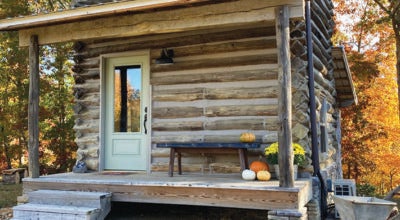The Literary Corner: Renegade Writer’s Guild
Published 9:26 am Thursday, January 30, 2020
|
Getting your Trinity Audio player ready...
|
“Death of the Aged Barn”
By Julie Terry Cartner
What would she say if she could talk? What stories could she share if she had words? What secrets did she hold within her wooden planks bowed and cracked with age? How did she feel when the old, powerful draft horses were augmented, then eventually replaced, by tractors? When that first John Deere A pop-popped its way into the deep recesses of her sheltering arms, did she know that one day the horses would all be replaced, their sweet hay scented breath and soft whiskers exchanged, first with the A, then with a plethora of other tractors.
Did she sigh in sympathy as Great-Grandpa’s cracked and callous filled hands, regardless of the weather or time of year, squeezed and pulled on milk-filled udders, filling shiny tin buckets with sweet, warm, frothy milk? Did she smile at the antics of barn cats and dogs vying for a taste of the expertly streamed milk directed by those self-same hands? And how did she feel when electric milkers replaced the strain and struggle of time-worn hands? Two times a day, 365 days a year, the placid cows entered the barn for food and milking until they were phased out, replaced by beef cattle.
Did she grieve when the last cow boarded the old, blue stock trailer, the era of cows coming to an end with the clang of metal as the gate slammed shut behind the last hoof and the truck and trailer rounded the big curve in the gravel driveway?
Standing tall and proud, the old barn served generations of farmers. Though designed for purpose and use, its high arches and beams unintentionally created a beauty that only old barn wood, silvered by time and weather, could portray. A home to hay, tractors, cows, and farm equipment, this practical multi-purpose edifice’s stalwart walls kept the interior warm and dry. Burrowed in the cracks and crevices between asymmetrical round hay bales, barn cats and farm dogs shared the comforting space.
But in the way of practical things such as barns, that same space that housed so many necessities of back-breaking, soul-crushing farm life could not possibly contain the exuberance of generations of children, as that same barn was the scene of races and contests, challenges and adventures, combined with healthy doses of imagination.
At times a pirate ship, a stage coach, or a secret garden, and at others a club house, a circus tent, a rappelling tower or a spelunking cavern as small, lithe bodies with stick, straight arms lowered themselves into the deep recesses between fragrant bales of sun dried hay, the grand old barn never disappointed.
In her golden years, the gracious old lady began listing to one side. As season by season the list became greater, bets were made as to how much longer she would survive, and yet, the outward jokes were shadowed by dread at the thought of the old lady’s demise.
Time continued to take its toll, augmented by the vagrancies of weather, until an unusually deep and heavy snow created more weight than she could handle. A lady to the end, her passing came silently, with a creak and a moan rather than a shriek of despair. The grand old lady regally bowed her head to the unstoppable power of age, weather and time, and sank gracefully to the ground, never to rise again.
“Suffrage for Women Centennial”
By Marie Craig
After decades of campaigning, demonstrating, and being jailed for their beliefs, women were finally given the privilege of voting in the United States one hundred years ago. Initially introduced to Congress in 1878, women had to wait for 41 years for this to be passed on the Federal level. Congress passed the 19th Amendment on 18 August, 1919. But it still had to be ratified by 36 of the 48 states to become law. Tennessee was the last state to do so. On 26 August 1920, there was finally a law that the right of citizens to vote “shall not be denied or abridged by the United States or by any State on account of sex.”
In Davie County, there was only one newspaper in 1920 which featured a slant toward the Republican Party. Some of these articles from 1920 are interesting to read.
North Carolina did not ratify this amendment, and when it seemed that Tennessee would agree to be the 36th state and therefore meet the quota, 63 of the 120 members of the lower house of the North Carolina legislature sent a letter to the Tennessee Legislature “assuring that body that North Carolina will not ratify the federal suffrage amendment and asking that the measure be not forced upon the people of North Carolina by Tennessee.” North Carolina finally ratified this in 1971.
From the Davie Record, in 1920 “John Parker, the Republican nominee for Governor has stumped the State in favor of suffrage, while Cameron Morrison, Democratic nominee, has remained at home and is opposed to the women voting. Wonder which of these men will receive the women’s vote this fall.”
“North Carolina wouldn’t but Tennessee did–so the ladies can get busy and see that all the sisters vote this fall.”
Mrs. Theodore Roosevelt’s letter was printed in the 27 October 1920 Davie Record. She encouraged women to vote for Republican candidates Senator Harding and Governor Coolidge. A few quotes from her letter: “Only the full measure of Americanism in the next administration can be attained if the people shall declare for the party which holds true nationalism as its high ideal. It is not necessary to forget our duty at home.”
The 3 November 1920 edition of the Davie Record featured this editorial right after an election. “The battle is over–a great victory has been won in Davie County and the ladies are responsible for the big Republican majority that was rolled up yesterday.”
Many women risked ridicule and actual imprisonment before 1920 in their determination to gain suffrage for all genders in the United States. Sometimes we take that for granted.
“Grandma”
By Gaye Hoots
My grandmother, Bessie Elizabeth Spainhour, was born Feb. 4, 1894 to Sarah Carolyn Butner Spainhour and Oliver Alexander Spainhour near Tobaccoville N.C., which is in Forsyth County. Their first child, Ernest Sidney Spainhour, was born on Dec. 7, 1891. Cornelius Alexander Spainhour arrived on Jan. 24, 1893. Bessie was the first girl born to the family. Her sister Annie Elvira Spainhour arrived on July 26, 1895, a sister, Florence M. Spainhour was born in February 1897, and in October 1899 another girl, Harriet P. Spainhour, was delivered but did not survive. Sources that say Sarah lost two other children, but no record of their birth was recorded, perhaps the births were not live births.
This birth rate was typical for the time; both Bessie’s parents came from larger families. Oliver Spainhour had a brother two years older, Julius Edward Spainhour, who married Sarah Butner’s sister, Paulina Alice Spainhour. Their children were born in the same time frame.
Oliver Spainhour was born a few months before the Civil War ended. The South was struggling, but both the Spainhour’s and Butner’s had enough land to grow their food and owned cows for milk. Oliver’s father, Christian Theophilus, joined his brother, William, known as Billy, in establishing a large grist mill and sawmill known as Spainhour’s Mill. The community depended on the mill to grind their grain and to split their lumber. The families maintained a livable income.
The birth of multiple children in eight years took its toll on Sarah Butner, Bessie’s mother. Shortly after the birth and death of her last child, Sarah was struggling. One evening she wandered away from their home with the youngest child in her arms. Family and neighbors searched for her all night. When she was found, with the baby safe, she was losing touch with reality.
There were no psychiatric meds in those days and few mental health facilities. No one had heard of post-partum depression or many other mood disorders. Because Sarah’s family feared for her life and the safety of her children, they took her to Morganton, N.C., where an institution had been built to house those who could not function at home. The original name was Insane Asylum. Some counties housed this population with others who were destitute in what were known as Poor Houses on County Farms.
Bessie was seven years old when her mother disappeared from her life. She only saw her mother a few times before Sarah died in 1916. The trip from Tobaccoville to Morganton by horse and wagon was daunting. Oliver had to run the mill and farm their land to feed the five children at home. Girls in those days were taught to cook and do household chores. The boys helped in the mill, gardened, and milked the cows.
Oliver built a wooden stool for Bessie to stand on to reach the table used as counter space in their kitchen. He tied one of her mother’s aprons on her, and with her grandmother’s directions, she learned how to make biscuits. Soon Bessie was preparing basic meals for the family. She and her younger sister Annie learned to handle the other household duties and looked after Florence who was three years old when Sarah left them.
From the time she was 7 years old until she was 16, Bessie prepared the family meals, did the laundry, churned butter, looked after the chickens and collected eggs, and substituted as mother to her sisters. Bessie taught Annie to help with all the chores and care for Florence who learned to help as she grew older.
The children grew and thrived, formed friendships, and helped each other. The boys carried a heavy workload in the mill and on the farm, but so did all the other boys in the community. Bessie and Annie mastered the more difficult dishes, and became good cooks and housekeepers, as did their cousins and friends. They were good students and faithful church members.
Bessie was the first to leave the family home. She met Robey Riley Fulk, and in1910 at the age of sixteen, became his wife. He was seven years older than her and was a farmer. They moved into a small cabin on his farm. Like her mother, Bessie had a daughter born the first year of her marriage. The little girl did not survive. Robey Fulk’s younger brother married Bessie’s younger sister Annie, so their bond remained very strong.
Bessie had the first four of her seven children before Sarah died in Morganton. Her family brought her home to buried at Mt. Pleasant Methodist Church, their family church. Three years after her mother’s death, Oliver Spainhour married Sarah’s younger sister, Emma Elizabeth, who brought the family together for holiday meals and filled the role of mother for them.
Bessie lived to be 99 years old and was one of the strongest and most family-oriented women I have ever known. She was beloved by her family, her friends, and her church.





